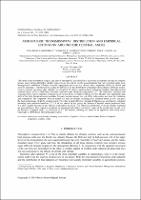| dc.contributor.author | Baigorria, Guillermo | |
| dc.contributor.author | Villegas, Esequiel B. | |
| dc.contributor.author | Trebejo, Irene | |
| dc.contributor.author | Carlos, Jose F. | |
| dc.contributor.author | Quiroz, Roberto | |
| dc.date.accessioned | 2021-06-25T21:20:22Z | |
| dc.date.available | 2021-06-25T21:20:22Z | |
| dc.date.issued | 2004 | |
| dc.identifier.issn | 1097-0088 | |
| dc.identifier.uri | https://hdl.handle.net/20.500.12542/993 | |
| dc.description.abstract | This study of the distribution in space and time of atmospheric transmissivity τ takes into account the fact that, in complex
terrain, many factors affect this variable; thus, it is not possible to use the generalizations that can be applied under more
homogeneous conditions. Climatic controls, topography and even sea currents have important effects on clouds and
aerosols affecting τ , simultaneously leading to differences in the distribution of incident solar radiation. Different models
exist to estimate incoming solar radiation as a function of relative sunshine hours (observed sunshine hours/theoretical
sunshine hours, n/N) or differences between maximum and minimum temperatures T . We calibrated, validated and
evaluated four of these empirical relations based on data from 15 weather stations in Peru. Models were calibrated using
66% of the daily historical record available for each weather station; the rest of the information was used for validation
and comparison. The Angstr ˚ om–Prescott model was used to estimate incoming solar radiation based on ¨ n/N, and gave
the best performance of all the models tested. The other models (Bristow–Campbell, Hargreaves, and Garcia) estimated
incoming solar radiation based on T . Of all the models in this group, the Bristow–Campbell model performed best;
it is also valuable because of the physical explanation involved. The empirical coefficients of all the models evaluated
are presented here. Two empirical equations are proposed with which to estimate values of the coefficients bB and cB in
the Bristow–Campbell model, as a function of T and latitude, allowing the model to be applied to other study areas.
Copyright 2004 Royal Meteorological Society | es_PE |
| dc.format | application/pdf | es_PE |
| dc.language.iso | eng | es_PE |
| dc.publisher | John Wiley & Sons | es_PE |
| dc.relation.uri | https://rmets.onlinelibrary.wiley.com/doi/abs/10.1002/joc.1060 | es_PE |
| dc.rights | info:eu-repo/semantics/openAccess | es_PE |
| dc.rights | Reconocimiento - No comercial - Sin obra derivada (CC BY-NC-ND) | es_PE |
| dc.rights.uri | https://creativecommons.org/licenses/by-nc-nd/4.0/ | es_PE |
| dc.source | Repositorio Institucional - SENAMHI | es_PE |
| dc.source | Servicio Nacional de Meteorología e Hidrología del Perú | es_PE |
| dc.subject | Radiación | es_PE |
| dc.subject | Atmospheric Transmissivity | es_PE |
| dc.subject | Solar Radiation. | es_PE |
| dc.subject | Modelos y Simulación | es_PE |
| dc.subject | Ångström–Prescott Model | es_PE |
| dc.title | Atmospheric transmissivity: distribution and empirical estimation around the central Andes | es_PE |
| dc.type | info:eu-repo/semantics/article | es_PE |
| dc.identifier.doi | https://doi.org/10.1002/joc.1060. | |
| dc.source.journal | International Journal of Climatology | es_PE |
| dc.subject.ocde | https://purl.org/pe-repo/ocde/ford#1.05.08 | es_PE |
| dc.subject.ocde | https://purl.org/pe-repo/ocde/ford#1.05.09 | es_PE |
| dc.publisher.country | PE | es_PE |
| dc.subject.sinia | radiaciones ionizantes y no ionizantes - Aire y Atmósfera | es_PE |
| dc.type.sinia | text/publicacion cientifica | es_PE |
| dc.identifier.url | https://hdl.handle.net/20.500.12542/993 | |
| dc.identifier.url | https://hdl.handle.net/20.500.12542/993 | |









